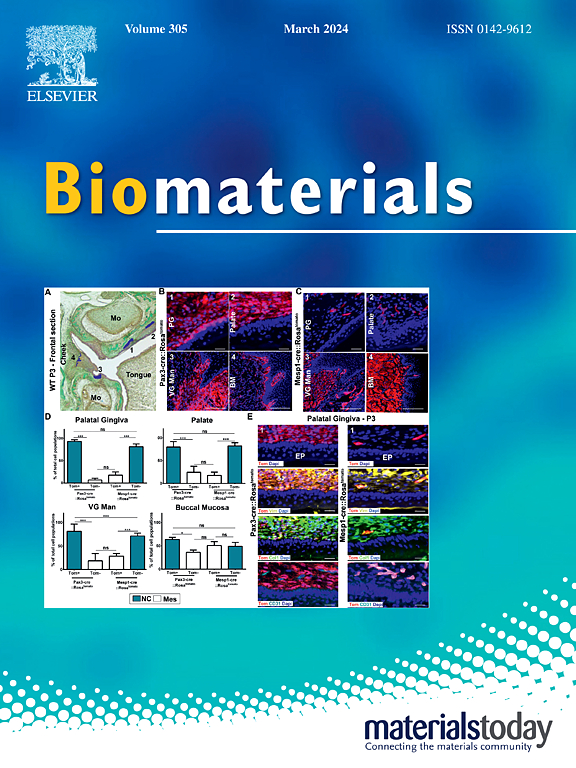用于预防医疗植入物相关感染的疏水-阳离子两致病性可转化抗菌多肽
IF 12.8
1区 医学
Q1 ENGINEERING, BIOMEDICAL
引用次数: 0
摘要
抗菌肽(AMPs)表面固定化在种植体上对耐药细菌感染有很好的疗效。抗菌肽的阳离子两亲性结构虽然对其有效的抗菌活性至关重要,但对在植入物上实现可扩展涂层提出了重大挑战,并有助于其对正常组织/细胞的细胞毒性。在此,我们开发了一种疏水-阳离子两致病性可转换AMPs (HAT-AMPs),用于医疗植入物的可扩展涂层,有效防止细菌感染,同时对正常组织具有低细胞毒性。hat - amp由可电离和疏水残基组成,在生理pH条件下具有疏水性和电中性,使其非常适合在钛表面物理固定,同时对正常组织具有最小的毒性。在感染过程中的酸性环境中,可电离单元的质子化诱导hat - amp采用阳离子两亲性结构,通过靶向细菌磷脂磷脂酰甘油显著增强其抗菌活性。该涂层固定于钛种植体表面后,具有良好的安全性,并在小鼠皮下感染模型中显示出较强的抗菌效果和良好的伤口愈合潜力。该策略为制造感染反应性种植体涂层提供了一种有效的方法。本文章由计算机程序翻译,如有差异,请以英文原文为准。
Hydrophobicity-to-cationic amphipathicity transformable antimicrobial polypeptides for the prevention of medical implant-associated infections
Surface immobilization of antimicrobial peptides (AMPs) on implants offers promising efficacy against drug-resistant bacterial infections. The cationically amphipathic structure of AMPs, while crucial for their potent antimicrobial activity, poses substantial challenges for achieving scalable coatings on implants and contributes to their cytotoxicity toward normal tissues/cells. Herein, we developed hydrophobicity-to-cationic amphipathicity transformable AMPs (HAT-AMPs) for scalable coating on medical implant, effectively preventing bacterial infections while exhibiting low cytotoxicity to normal tissues. The HAT-AMPs, composed of ionizable and hydrophobic residues, are hydrophobic and electrically neutral at physiological pH condition, making them highly suitable for physical immobilization on titanium surfaces while exhibiting minimal toxicity to normal tissues. In acidic environments during infections, the protonation of ionizable units induces HAT-AMPs to adopt a cationically amphipathic structure, remarkably enhancing their antimicrobial activity by targeting bacterial phospholipid phosphatidylglycerol. When immobilized on titanium implant surface, the coating exhibited a favorable safety profile, and demonstrated strong antibacterial efficacy and promising wound-healing potential in a subcutaneous infection mouse model. This strategy offers an efficient approach for fabricating infection-responsive implant coatings.
求助全文
通过发布文献求助,成功后即可免费获取论文全文。
去求助
来源期刊

Biomaterials
工程技术-材料科学:生物材料
CiteScore
26.00
自引率
2.90%
发文量
565
审稿时长
46 days
期刊介绍:
Biomaterials is an international journal covering the science and clinical application of biomaterials. A biomaterial is now defined as a substance that has been engineered to take a form which, alone or as part of a complex system, is used to direct, by control of interactions with components of living systems, the course of any therapeutic or diagnostic procedure. It is the aim of the journal to provide a peer-reviewed forum for the publication of original papers and authoritative review and opinion papers dealing with the most important issues facing the use of biomaterials in clinical practice. The scope of the journal covers the wide range of physical, biological and chemical sciences that underpin the design of biomaterials and the clinical disciplines in which they are used. These sciences include polymer synthesis and characterization, drug and gene vector design, the biology of the host response, immunology and toxicology and self assembly at the nanoscale. Clinical applications include the therapies of medical technology and regenerative medicine in all clinical disciplines, and diagnostic systems that reply on innovative contrast and sensing agents. The journal is relevant to areas such as cancer diagnosis and therapy, implantable devices, drug delivery systems, gene vectors, bionanotechnology and tissue engineering.
 求助内容:
求助内容: 应助结果提醒方式:
应助结果提醒方式:


